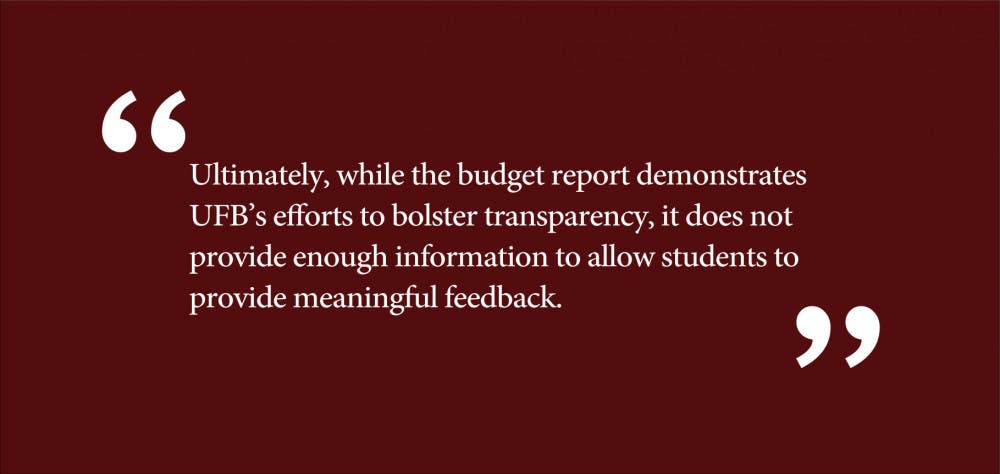On Nov. 21, the Undergraduate Finance Board released its budget report for the 2018-2019 academic year. According to the report, UFB’s approximately $2.2 million budget comes primarily from the $286 student activities fee all Brown students must pay. UFB’s budget report describes its allocation process at length, and breaks down the budget into broad categories of expenditures, such as event support, annual budgeting and supplemental budgeting. But, while the budget report is helpful in demonstrating broad categories of organizations and services funded by the activities fee, it is not detailed enough — especially considering how high our student activities fee is compared to our Ivy League peers. In future budget reports, the UFB should continue to increase transparency around the activities fee so undergraduates can have a clearer idea as to how their money is being used; release the reports on time; and provide more granular details about the allocation of the budget.
Of the Ivy League institutions that list their student activities fees online, the University has the highest fee. (Princeton and Penn include their activities fees in larger expenses; they do not make available the student activities fees they charge.) Dartmouth has the lowest activities fee, at $75, while Cornell, the school with the second-highest fee in the Ivy League, still only charges students $234. Because the University has a relatively high fee, it is even more important for students to clearly understand which initiatives and organizations their money is supporting. Going forward, the UFB should explain why our student activities fee is so high when compared to our peers, and how the University determines the activities fee.
The student activities fee is primarily associated with student groups and clubs. However, UFB also funds many initiatives and activities on campus that one might intuitively deem the financial responsibility of the University. For example, $75,000 of the budget is given to Club Athletics. These 11 club sports teams are all managed by the Department of Athletics, yet continue to receive UFB funding and follow UFB policies. It is unclear why Athletics does not supply the funding for club sports. An additional chunk of the budget is given to the Sarah Doyle Women’s Center, the LGBTQ Center and the Brown Center for Students of Color. While these organizations are extremely important to the Brown community and deserve adequate funding, it is similarly unclear why the University does not fully fund these affinity centers and why they must rely on the student activities fee for support.
To its credit, UFB has taken a fairly significant step toward greater transparency this year by publishing a report about its budgeting process. But it is important that these reports be released on the timeline set by UFB’s own members so that undergraduates have the time to read and digest them fully. UFB’s first budget report was initially projected to be released at the end of September. The report has instead come at the end of November. For the majority of the first half of the school year, therefore, students had no way of knowing how their activities fee was being spent. UFB has stated that it hopes the student body gives feedback on fund allocation, but in late November, no changes can reasonably be articulated and enacted this semester.
Finally, the report does not include enough information for students to fully understand the budget. While the groupings provide some structure, almost 51 percent of the funds falls under “Annual Budgeting,” a nebulous category that includes all student organization funding that is predicted at the end of the spring term for the following year. Brown has over 400 clubs and student organizations, and it would be useful to learn how much money each organizationreceives, particularly the largest recipients of UFB funding. This breakdown is certainly feasible; the Cornell Student Assembly published an allocation overview for 2010 to 2018, naming each organization and how much money it receives from the student activities fee. This level of transparency allows students to advocate for the specific changes they would like to see in the budget in more detail than is currently possible. In a similar vein, UFB ought to take another cue from Cornell and offer more historical background about the student activities fee. This would better allow students to understand the purpose of the fee and how it has changed over time.
Ultimately, while the budget report demonstrates UFB’s efforts to bolster transparency, it does not provide enough information to allow students to provide meaningful feedback. Nor does it explain why our student activities fee is significantly higher than that of our peers. UFB Vice Chair Julian De Georgia ’20 told The Herald that UFB plans to publish more detailed reports in the coming years. We hope that these reports will give a breakdown that makes it simple for students to see how their money is being used and lead to a more informed and sustained conversation about our activities fee.
Editorials are written by The Herald’s editorial page board: Anuj Krishnamurthy ’19, Rhaime Kim ’20, Grace Layer ’20, Mark Liang ’19 and Krista Stapleford ’21. Please send responses to this opinion to letters@browndailyherald.com and op-eds to opinions@browndailyherald.com.



